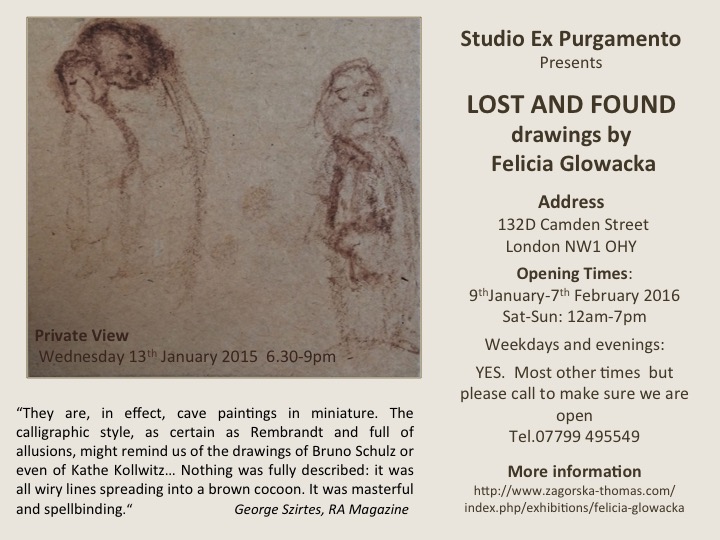LOST AND FOUND - drawings by Felicia Głowacka
Jan 9th - Feb 7th
Open: Sat-Sun: 12am-7pm
Weekdays and evenings: We are open most of the time but please call to make sure you'll find us in. Tel: 07799 495549

A London gallery has unveiled a cache of tiny figure
Drawings by a little known Polish artist, whose work shows
a mastery of gestural skill. GEORGE SZIRTES is smitten
“At Natalia Zagorska-Thomas’s private gallery in Camden Town, Studio Ex Purgamento, in a small oblong room, among works by various contemporary women artists under the heading ‘Secrets and Lies’ there was a group of tiny drawings by a long-dead Polish artist called Felicia Glowacka. The drawings had been rescued from a shop in Warsaw where they formed a complete, if apparently miscellaneous, portfolio and now here they were, two or three of them, framed and displayed for the first time in what must have been a good many years. They were immediately intriguing, a small selection from some sixty works, half of which were here in England with Zagorska-Thomas who first found them, the other half with her father in Warsaw. We wanted to see more.
[…]
Who was Glowacka? What survives of catalogue notes tells us is that she was born in 1896 into a family of some intellectual standing, that she trained as a dentist and that, having survived the Warsaw Uprising, she started painting very late in 1948 without any formal training but became seriously ill soon after and died in 1953. She wasn’t altogether unknown in her time, her work, of which there must considerably more than we can see and which apparently included paintings, having being exhibited at two National Museums in Poland. There is even a photograph of her with Picasso. The catalogue notes relate to a posthumous exhibition in 1957: the rest is, so far, a mystery.
[…]
It is interesting to know Glowacka was a dentist. There is something tooth-sized, delicate, yet tough about the work that might in fact fit into a mouth. They are, in effect, cave paintings in miniature. The calligraphic style, as certain as Rembrandt and full of allusions, might remind us of the drawings of Bruno Schulz or even of Kathe Kollwitz but it has a more substantial context in Polish art, in the work of artists such as Stansislaw Witkiewicz and Witold Wojtkiewicz of the Mloda Polska (Young Poland) school at the turn of the twentieth century”.
Small Wonder, George Szirtes, RA Magazine, Winter 2015

